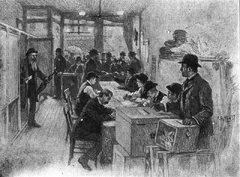
Voting in the Quebec Plebiscite, 1889.
The Quebec Plebiscite was a referendum held on 6 July 1889 in the Confederation of Quebec to determine its relationship with the Confederation of North America. The people of Quebec voted by a majority of 54% to become an associated state of the C.N.A., with considerable local autonomy but without full membership in the Confederation.
There had been a number of uprisings in Quebec in the 19th century, beginning with the Papineau Revolt of September 1839. In his first inaugural address in February 1888, Governor-General Ezra Gallivan stated that "Quebec has real and long-standing grievances against the national administration" and pledged that "every attempt will be made to secure the full loyalty of every citizen of that important state." Gallivan followed this with a visit to Quebec City, where he ignored assassination threats by the Patriotes by walking among the crowds, and delivering a speech to the Francophone populace ending with the words, "I have heard, and I have understood."
Nearly a year later, on 1 February 1889, Gallivan appeared before the Grand Council to deliver a message on Quebec, offering a plan "to determine the future of the Confederation of Quebec, its relations with the national government, and the will of its people." Gallivan proposed that a plebiscite be held in Quebec that summer, offering its people a choice of
- Remaining within the C.N.A. as presently constituted;
- Becoming as "associated state" with significant local autonomy but without full membership in the C.N.A.; or
- Independence, with those wishing to leave being assisted in doing so by the national government.
Following Gallivan's speech, the thirteen-member delegation from Quebec rose to cheer him, followed by polite applause from the rest of the Grand Council. The next day, most of the C.N.A.'s newspapers supported Gallivan's proposal. The proposal passed the Grand Council on 9 February, with the date of the plebiscite set for Saturday, 6 July.
Three parties appeared in Quebec during the five-month runup to the plebiscite: the largest was the pro-independence Free Quebec Coalition, which included the Patriotes. The smallest was the pro-C.N.A. Loyalty Party, which included wealthy businessmen and monarchist exiles from France. In between was the pro-association Justice and Peace Party, which included middle-class farmers and Quebecois with ties to Nova Scotia. Supporters of the Free Quebec Coalition destroyed opposition offices and threatened an uprising if the vote did not go for independence. However, the attempt at intimidation backfired. Support for the Free Quebec Coalition fell, and on 6 July a majority of Quebecois voted for associated status:
| Alternative | Votes | % |
|---|---|---|
| Associated Status | 995289 | 54 |
| Independence | 756,344 | 41 |
| Confederation Status | 92,456 | 5 |
| Total | 1,844,089 | 100 |
Following the plebiscite, Gallivan called for a special session of the Quebec legislature "to implement the will of the people." The results of the plebiscite were ratified in October 1889, after which Quebec had full control of internal affairs while remaining associated with the C.N.A. "on issues of common interest." Quebec's seats in the Grand Council were redistributed to the other six confederations after the 1890 census, though Quebec retained the right to send three observers to the Council.
After the Quebec Plebiscite, For Want of a Nail ... does not follow events in Quebec.
Sobel's source for the Quebec Plebiscite is Armond Fleur's We Leave as Friends: The 1889 Plebiscite (New York, 1945).
